The DASH diet is a nutritional diet plan designed to lower blood pressure, featuring a focus on fruits, vegetables, whole grains, and lean proteins while limiting sodium, sugar, and unhealthy fats. According to Dr. Hima J. Challa, MD, the primary benefit of the DASH diet is its effectiveness in lowering hypertension and its additional advantages in managing metabolic syndromes, aiding weight management, and reducing the risk of various chronic diseases like cardiovascular issues and type 2 diabetes.
One of the main drawbacks of the DASH diet is that it may be challenging to follow for those who are used to high-sodium and processed foods, potentially leading to an initial period of adjustment. The DASH diet’s importance lies in its evidence-based approach to improve cardiovascular health, lower hypertension, and promote overall well-being, making it a recommended choice by organizations like the American Heart Association.
What is the DASH Diet?
The DASH diet, which stands for Dietary Approaches to Stop Hypertension, is a nutritionally-based approach to prevent and control high blood pressure. It focuses on consuming vegetables, fruits, lean meats, and dairy products, and reducing sodium intake.
The DASH diet recommends specific servings per day, such as 4-5 servings of vegetables, 4-5 servings of fruits, 6-8 servings of grains, and 2-3 servings of low-fat dairy products.
What is the effect of the DASH Diet on hypertension?
The DASH diet effectively lowers blood pressure, reducing systolic blood pressure by an average of 3.2 mm Hg and diastolic blood pressure by an average of 2.5 mm Hg, according to a 2020 study by Christina D. Filippou from the National and Kapodistrian University of Athens. This impact is significant in both hypertensive and non-hypertensive adults.
The study involving 5,545 participants found the blood pressure-lowering effect was more pronounced in trials with participants who had a daily sodium intake greater than 2,400 mg and with participants who were younger than 50 years old. The DASH diet’s impact was significant in lowering hypertension, making it a versatile choice for blood pressure management.
How does the DASH Diet work?
The DASH Diet operates on a two-phase approach designed to foster heart health and lower blood pressure. In the initial two-week phase, known as Phase 1, the focus is on metabolic reset and blood sugar stabilization.
This is achieved by eliminating whole grains and fruits while encouraging the consumption of lean proteins, like meat and fish, in 6-8 oz servings and allowing for an unlimited intake of non-starchy vegetables.
After resetting the metabolism in Phase 1, Phase 2 reintroduces balanced eating by bringing back whole grains and fruits. This long-term phase promotes 4-5 servings each of both non-starchy and starchy vegetables like potatoes, as well as fruits.
Throughout both phases, the diet emphasizes the intake of nutrients such as potassium, magnesium, calcium, and fiber, while keeping sodium levels below 2.3 grams per day to achieve noticeable blood pressure reductions within a week.
How does the DASH Diet work for body composition?
The DASH Diet has a beneficial impact on body composition, according to a 2016 study by Sepideh Soltani from the Iran University of Medical Sciences.
The research indicated that adults following the DASH Diet experienced a significant reduction in body weight, with a weighted mean difference of -1.42 kg over 8-24 weeks, a decrease in BMI by -0.42 kg/m² over 8-52 weeks, and a reduction in waist circumference by -1.05 cm in 24 weeks, compared to controls.
The diet was particularly effective when it was low in calories, leading to even greater weight reduction compared to other low-energy diets. The study concluded that the DASH Diet is particularly effective for weight management and is especially beneficial for overweight and obese individuals. This diagram shows the effects of the DASH diet on body composition.
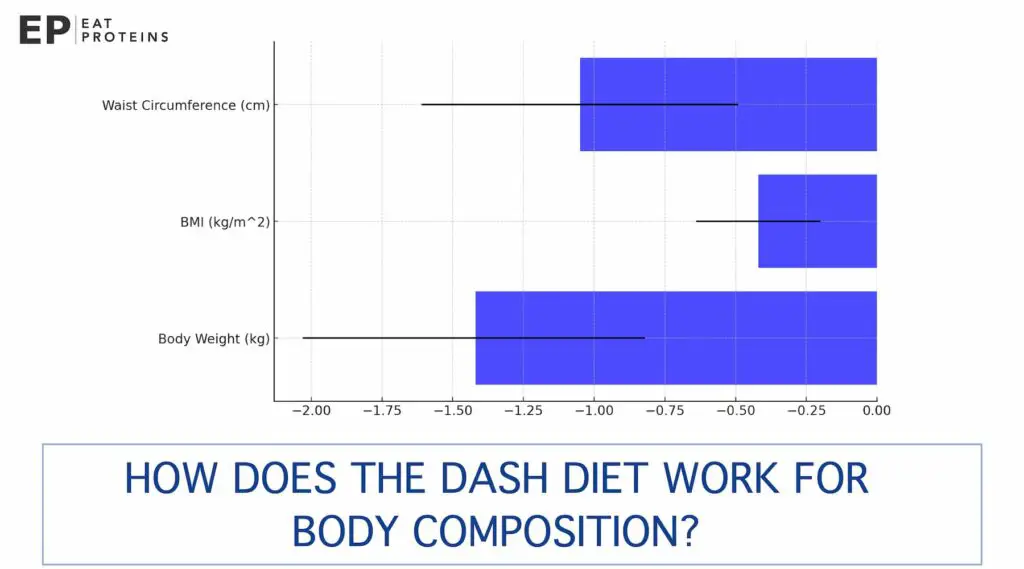
What are the types of DASH diet?
The types of DASH diets include Mediterranean DASH Diet, Gluten-Free DASH Diet, Indian DASH Diet, Japanese DASH Diet, and Korean DASH Diet, each tailored to different dietary needs and cultural preferences.
- Mediterranean DASH Diet: This version combines the principles of the DASH diet with the Mediterranean diet, focusing on fruits, vegetables, whole grains, and healthy fats like olive oil, while also being low in sodium.
- Gluten-Free DASH Diet: This type of DASH diet is tailored for people with gluten sensitivities or celiac disease, and emphasizes gluten-free grains while still being low in sodium and high in fruits, vegetables, and lean proteins.
- Indian DASH Diet: Adapted to suit Indian cuisine, this version includes traditional Indian spices and foods that are low in sodium and high in fruits, vegetables, and lean proteins.
- Japanese DASH Diet: The Japanese DASH diet, also known as the DASH-JUMP diet, is a modified version of the DASH diet specifically designed for Japanese individuals with high-normal blood pressure or stage 1 hypertension. It involves consuming 8.0 grams of salt per day and following a 14-day menu cycle with 42 meals at two calorie levels (1820 and 1650 kcal)
- Korean DASH Diet: The Korean DASH diet is a modified version of the Dietary Approaches to Stop Hypertension (DASH) diet that is specifically tailored to Korean cuisine and culture. It is rich in grains, vegetables, nuts, and poultry while being low in sodium and red meat.
What is the most suitable type of the DASH diet for vegetarians?
The most suitable version of the DASH diet for vegetarians would be an Indian DASH diet, which modifies the original plan to exclude meat and other animal products. This version emphasizes plant-based proteins like legumes, tofu, and tempeh, while still focusing on low sodium intake, high-fiber foods, and a variety of fruits and vegetables.
What are the overall pros and cons of the DASH Diet?
The overall pros of the DASH Diet include its effectiveness in lowering blood pressure and reducing the risk of adverse cardiac events, stroke, type 2 diabetes, and obesity. It also promotes healthy eating habits and aids in weight management.
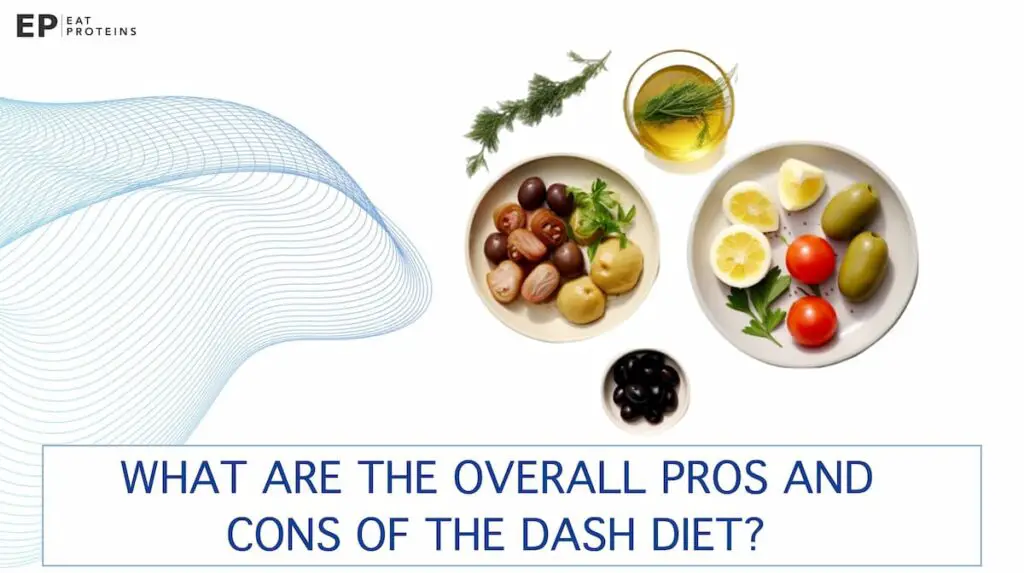
The DASH Diet has been extensively studied and has been shown to lower blood pressure by an average of 11.4 mm Hg systolic and 5.5 mm Hg diastolic.
On the other hand, the cons of the DASH Diet include the need for lifestyle changes and potential challenges in adherence. Compliance with the DASH Diet remains low, and further studies are needed to assess its long-term effectiveness.
What are the health benefits of the DASH Diet?
The following are the 12 health benefits of the DASH diet.
- Lower Blood Pressure: The DASH Diet reduces systolic blood pressure by an average of 3.2 mm Hg and diastolic blood pressure by 2.5 mm Hg. This is a significant reduction that can lower the risk of hypertension-related complications. These findings were supported by a comprehensive 2020 study published in Advances in Nutrition Journal.
- Cardiovascular Health: By following the DASH Diet, the risk of cardiovascular diseases like heart disease and stroke can be lowered by 20-40%. This can have a significant impact on long-term health and quality of life. The diet’s focus on low sodium and high fiber contributes to these benefits.
- Weight Management: The diet leads to an average weight loss of 1.59 kg and a reduction in BMI by 0.64 kg/m². This is particularly beneficial for individuals who are overweight or obese. These stats were revealed in a 2016 study by Sepideh Soltani from Iran University of Medical Sciences.
- Waist Circumference: Following the DASH Diet can decrease your waist circumference by 1.93 cm. A smaller waist circumference is linked to lower risks of metabolic syndrome and cardiovascular disease. These numbers are backed by a 2021 study by Abolfazl Lari from Iran University of Medical Sciences
- Cholesterol Levels: The diet significantly lowers total cholesterol by 5.12 mg/dl and LDL cholesterol by 3.53 mg/dl. Lowering these cholesterol levels can help prevent arterial plaque buildup, reducing the risk of heart disease. These effects were statistically significant, as per the same 2020 study.
- Blood Sugar Control: Although not significant, the DASH Diet has a tendency to lower blood glucose levels by 0.38 mg/dl. This can be beneficial for diabetes management and prevention. However, more research is needed to confirm these findings.
- Inflammation: The DASH Diet can reduce levels of the inflammatory marker high-sensitivity C-reactive protein by 0.33 mg/l. Lower levels of inflammation are beneficial for overall health and can reduce the risk of chronic diseases. However, this effect was not statistically significant.
- Cardiac Injury and Strain: The diet reduces biomarkers of cardiac injury and strain, such as high-sensitivity cardiac troponin I by 17.78% and hs-CRP by 19.97%. These reductions suggest that the DASH Diet may protect against subclinical cardiac injury and inflammation. These benefits accrue progressively over 12 weeks.
- Type 2 Diabetes: The diet helps in reducing the risk of developing type 2 diabetes, although exact numerical values are still under research. The diet’s high fiber and low sugar content are contributing factors.
- Obesity: The DASH Diet aids in weight reduction, especially beneficial for overweight and obese participants, as evidenced by a weight mean difference of -1.42 kg. This contributes to lower risks of various obesity-related health conditions.
- Colorectal Cancer: The diet shows potential in lowering the risk of colorectal cancer. However, exact numerical values quantifying this benefit are still under research. High fiber and low saturated fat content are contributing factors.
- Insulin Resistance: The diet has been found to improve insulin resistance, although exact numerical values are still under investigation. Improved insulin sensitivity can make it easier to control blood sugar levels and may lower the risk of type 2 diabetes.
What are the health risks of the DASH Diet?
The DASH Diet is generally considered safe and has been extensively researched for its health benefits, particularly in lowering blood pressure and improving cardiovascular health.
While no significant adverse effects have been reported in systematic reviews and meta-analyses, some individuals may experience temporary gas and bloating due to the diet’s high fiber content. It’s important to consult a healthcare professional for personalized advice before starting any new diet, especially if you have existing health conditions.
How to start the DASH Diet?
To start the DASH diet effectively, please refer to the list below.
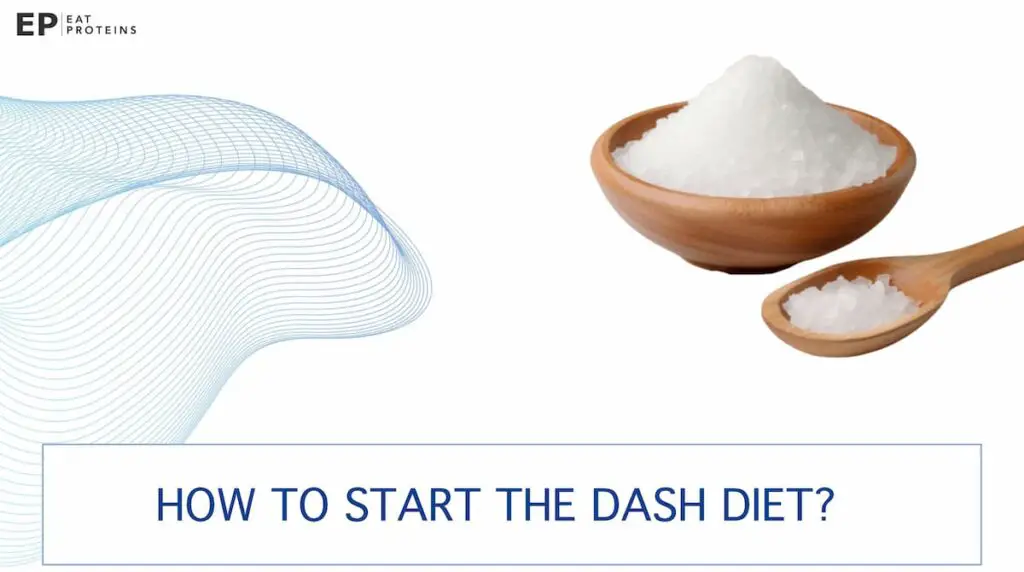
- Incorporate vegetables into your meals by aiming for several daily servings.
- Consume fruits daily, aiming for multiple servings.
- Include whole grains in your diet, such as whole wheat bread or brown rice.
- Choose low-fat or fat-free dairy products, like skim milk or Greek yogurt.
- Opt for lean meats, poultry, and fish, limiting your intake to 6 servings or fewer per day.
- Add beans, nuts, and seeds to your meals as sources of protein and healthy fats.
- Utilize vegetable oils, like olive or canola oil, for cooking and dressing.
- Limit your intake of sodium to 2,300 milligrams or less per day.
- Minimize consumption of sweets and sugar-sweetened beverages to 5 servings or fewer per week.
What foods are allowed on the DASH diet?
The following foods are allowed on the DASH diet.
- Grains: Daily servings of 6 or fewer.
- Meats, poultry, and fish: Daily servings of 6 or fewer.
- Vegetables: Daily servings.
- Fruits: Daily servings.
- Low-fat or fat-free dairy products: Daily servings.
- Fats and oils: Daily servings.
- Sodium: Daily intake is limited to 2.3 grams, with an even lower limit of 1.5 grams recommended for further blood pressure reduction.
- Nuts, seeds, dry beans, and peas: Weekly servings.
- Sweets: Daily servings are limited to 5 or fewer.
In the DASH diet, fruits and vegetables like apples, bananas, oranges, broccoli, and carrots are recommended as they are rich sources of potassium, magnesium, and fiber, as outlined in this table.
| Food Group | Examples of Foods |
|---|---|
| Grains | Whole wheat bread, oatmeal, brown rice |
| Vegetables | Broccoli, carrots, spinach, kale |
| Fruits | Apples, bananas, oranges, strawberries |
| Dairy | Fat-free milk, low-fat yogurt |
| Lean meats, poultry, fish | Skinless chicken, lean beef |
| Nuts, seeds, legumes | Almonds, lentils, split peas |
| Fats and oils | Soft margarine, olive oil |
| Sweets and added sugars | Fruit-flavored gelatin, sorbet |
What kind of meat is best for the DASH diet?
The DASH diet emphasizes consuming lean protein sources, such as skinless poultry and fish. These meats are low in saturated fat and provide essential nutrients like omega-3 fatty acids. Including 3-4 ounces (85-113 grams) of skinless poultry or fish in your meals can align with the DASH diet guidelines for optimal health and blood pressure management.
What fruits and vegetables are recommended in the DASH diet?
In the DASH diet, a variety of fruits and vegetables are recommended, particularly those that are rich in potassium, fiber, and other essential nutrients.
- Bananas
- Oranges
- Berries (strawberries, blueberries, raspberries)
- Apples
- Pears
- Grapes
- Spinach
- Kale
- Broccoli
- Carrots
- Sweet Potatoes
- Tomatoes
- Cucumbers
- Bell Peppers
- Avocado
What are the portion sizes in the DASH diet?
In the DASH diet, portion sizes are categorized by food group, with specific daily servings and serving sizes recommended for optimal health benefits. This table shows the portion sizes in the DASH diet.
| Food Group | Daily Servings | Serving Sizes |
|---|---|---|
| Grains | 6–8 | 1 slice bread 1 oz dry cereal 1/2 cup cooked rice |
| Vegetables | 4–5 | 1 cup raw leafy vegetable 1/2 cup cut-up vegetable |
| Fruits | 4–5 | 1 medium fruit 1/4 cup dried fruit |
| Fat-free or low-fat milk | 2–3 | 1 cup milk or yogurt 1 1/2 oz cheese |
| Lean meats, poultry, and fish | 6 or less | 1 oz cooked meats 1 egg |
| Nuts, seeds, and legumes | 4–5 per week | 1/3 cup nuts 2 Tbsp peanut butter |
| Fats and oils | 2–3 | 1 tsp soft margarine 1 tsp vegetable oil |
| Sweets and added sugars | 5 or less per week | 1 Tbsp sugar 1/2 cup sorbet |
What are the snack options in the DASH diet?
The DASH diet offers a wide range of snack options in every phase.
- DASH Diet Phase 1: During phase 1, snacks can include low-fat dairy foods like yogurt or cheese (1 serving), raw vegetables with dressing or hummus (1 cup), and lean proteins like deli slices (2-3 ounces).
- DASH Diet Phase 2: In phase 2, snacks can include fresh fruits (1 serving), whole grains like a wheat bagel or wild rice (1 serving), and unsalted pretzels (1 ounce).
What foods should you avoid on the DASH diet?
On the DASH diet, there are certain foods that should be avoided to achieve optimal results.
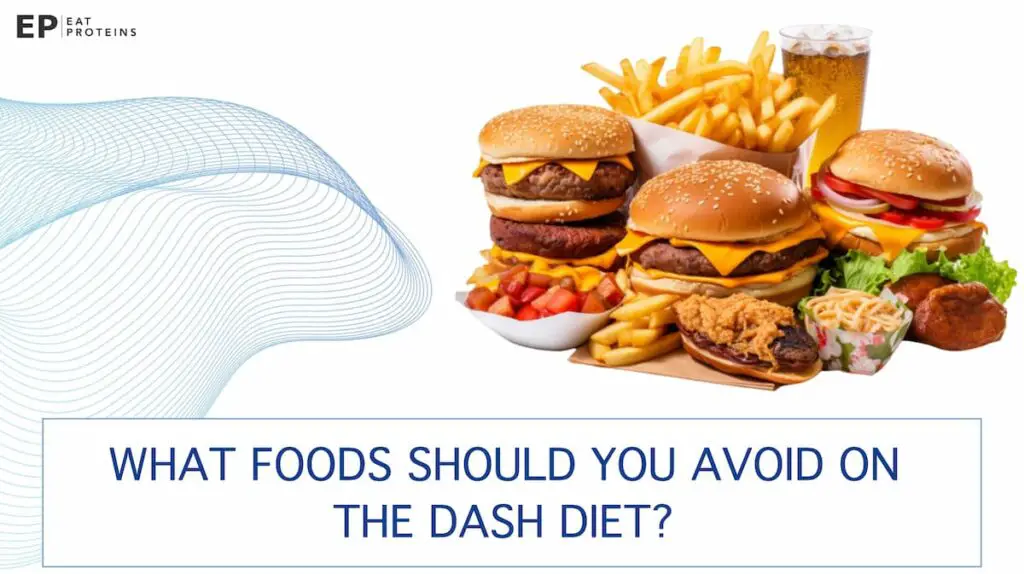
These include high-sodium foods such as processed meats, canned soups, and salty snacks. Additionally, foods high in saturated fats, such as fatty cuts of meat, full-fat dairy products, and coconut oil, should be avoided. It is advised to limit saturated fat intake to less than 6% of total daily calories.
What is the recommended sodium intake on the DASH diet?
The recommended sodium intake on the DASH diet is no more than 2,300 milligrams per day, with an ideal limit of 1,500 milligrams per day for adults who have high blood pressure or are at risk of developing it.
For example, opting for unsalted peanuts (0-5 mg sodium) over salted ones (120 mg sodium) or choosing fresh meat (30-90 mg sodium) over processed ham (1,020 mg sodium) can help you stay within these limits. These guidelines aim to lower blood pressure and reduce the risk of hypertension.
What is the DASH diet meal plan?
The DASH diet meal plan is a structured guide that outlines what to eat each day to help manage blood pressure. It typically focuses on reducing sodium intake while incorporating a variety of nutrient-dense foods rich in potassium, calcium, and magnesium.
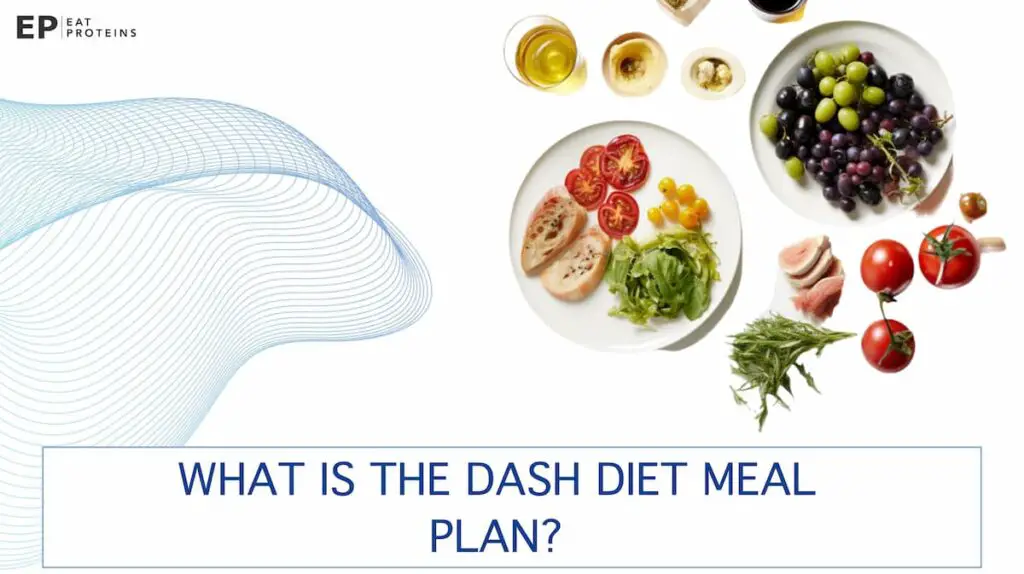
This table shows a 3-day meal plan for the DASH diet, adhering to a 2,300 mg sodium level.
| Day | Breakfast | Lunch | Dinner |
|---|---|---|---|
| Day 1 | Chicken salad on whole wheat bread, cucumber, and tomato salad with sunflower seeds | Chicken salad on whole wheat bread, cucumber and tomato salad with sunflower seeds | 3 oz beef with fat-free gravy, green beans, baked potato with fat-free sour cream |
| Day 2 | 1 cup oatmeal with blueberries 1 slice of whole-grain toast 1 cup low-fat milk | Tuna salad on whole-grain bread, carrot and celery sticks | Grilled chicken, quinoa, steamed broccoli |
| Day 3 | 2 scrambled eggs 1 slice of whole-grain toast 1 orange | Turkey and cheese sandwich on whole-grain bread, mixed greens salad | Baked salmon, brown rice, asparagus |
What’s on the DASH diet shopping list?
The DASH diet shopping list is a comprehensive guide to foods that align with the Dietary Approaches to Stop Hypertension (DASH) plan, which is designed to lower blood pressure and promote heart health.

Here is the table summarizing the DASH diet shopping list.
| Category | Recommended Items |
|---|---|
| Vegetables (fresh) | Artichokes, Asparagus, Beets, Bell peppers, Broccoli |
| Frozen Foods | Chicken breast, Fish fillets, French toast |
| Breads & Bakery | Whole wheat bagels, Bread, English muffins |
| Packaged Snacks | Whole grain crackers, Dried fruit, Popcorn |
| Condiments, Sauces, Spreads | Bean dip, Chili sauce, Hummus |
| Herbs and Spices | Allspice, Basil, Cayenne pepper |
| Beverages | 100% Fruit juice, Herbal tea, Sparkling water |
| Canned Goods | Unsweetened applesauce, Beans, Low-sodium broth |
| Cereal | Bran cereal, Whole grain cereal, Low-fat granola |
| Nuts & Seeds | Almonds, Cashews, Hazelnuts |
| Grains | Barley, Brown rice, Bulgur |
| Meat, Poultry, Seafood, Soy | Beef, Chicken, Eggs |
| Fruit (fresh) | Apples, Apricots, Bananas |
What are the best recipes for the DASH diet?
DASH diet recipes are culinary creations specifically designed to meet the guidelines of the DASH diet. These recipes aim to improve heart health and lower blood pressure by including ingredients rich in potassium, calcium, and magnesium, while minimizing saturated fats and added sugars.
- DASH Diet Breakfast Recipes: Best options often feature whole grains, fruits, and low-fat dairy, such as oatmeal with fresh berries and skim milk.
- DASH Diet Lunch Recipes: Ideal choices include lean protein, whole grains, and vegetables, like a grilled chicken salad with whole-grain bread.
- DASH Diet Dinner Recipes: Optimal recipes might involve grilled fish, steamed vegetables, and brown rice, focusing on balanced nutrients and low sodium.
- DASH Diet Snack Recipes: Healthier options typically feature fruits, nuts, and low-fat dairy, such as apple slices with almond butter or low-fat yogurt with fruit.
What you should know about the DASH diet?
The DASH diet is ranked as the best diet overall for the eighth year in a row by and World Report. It is designed to prevent and treat high blood pressure and lower blood cholesterol. Following the DASH diet can lead to a reduction in blood pressure in just two weeks.
According to the National Institutes of Health, combining the DASH diet with a low-sodium intake can reduce systolic blood pressure by 8 to 14 points, lowering the risk of cardiovascular disease.
How does the DASH diet compare to other diets?
When compared to other diets, such as the Mediterranean diet or low-sodium diet, the DASH diet consistently ranks among the top diets due to its focus on a balanced and nutritious eating plan.
It is particularly praised for its effectiveness in lowering blood pressure, reducing the risk of heart disease, and promoting overall health. The emphasis on whole foods, fruits, vegetables, and lean proteins sets it apart from many other diets.
How does the DASH diet compare to the Low-Sodium diet?
The DASH diet and the Low-Sodium diet both aim to lower sodium intake, but the DASH diet offers a more holistic approach by also emphasizing fruits, vegetables, and lean proteins. While the DASH diet recommends reducing sodium to about 1,500 mg/day, the Low-Sodium diet advises an intake below 2.3 g/day.
However, recent evidence suggests that a moderate sodium intake range of 3 to 5 g/day may be associated with the lowest cardiovascular risk, calling into question the strict sodium limitations of both diets.
How does the DASH diet compare to the Mediterranean diet?
Both the DASH diet and the Mediterranean diet prioritize whole foods, fruits, vegetables, and lean proteins, but their primary goals and nutritional guidelines differ. The DASH diet is specifically tailored to lower blood pressure, emphasizing a reduction of sodium intake to about 1.5 g grams per day and the consumption of minimally processed foods.
On the other hand, the Mediterranean diet aims for a broader range of health benefits, including reduced cardiovascular risk, better glycemic control, and even lower environmental impact, without placing a specific focus on sodium reduction.
What beverages are recommended on the DASH diet?
The DASH diet recommends consuming plenty of water as the main beverage choice. Additionally, low-fat milk, unsweetened tea, and coffee can be included in moderation. It is important to limit or avoid sugary beverages such as soda, sweetened tea, and fruit juices.
What are the DASH diet guidelines for alcohol consumption?
The DASH diet guidelines recommend moderate alcohol consumption, which is defined as up to one drink per day for women and up to two drinks per day for men. However, it is important to note that excessive alcohol intake can have negative effects on health and should be avoided.
Who were the creators of the DASH Diet?
The creators of the DASH Diet were the National Institute of Health’s National Heart, Lung, and Blood Institute (NHLBI). It was first introduced in 1997 and has been promoted by the NHBLI for reducing blood pressure. The DASH Diet has since been ranked as one of the “Best Overall Diets” and has shown numerous benefits for heart health and other clinical conditions.
How does the DASH diet affect sleep quality?
While the DASH diet is not directly linked to sleep quality, following a healthy eating pattern like the DASH diet can have positive effects on overall health, which may indirectly improve sleep quality. A balanced diet that includes nutrient-rich foods can support good sleep hygiene and contribute to improved sleep.
